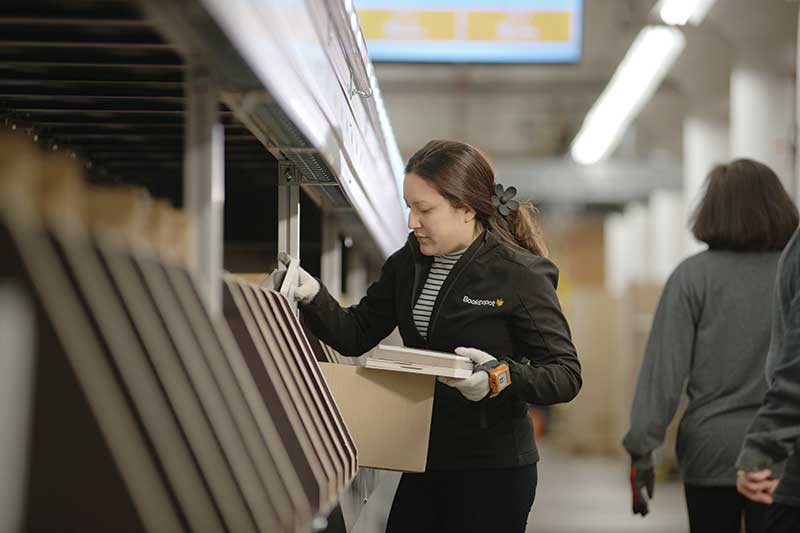Writing the book on streamlined data capture
Book Depot’s fulfillment center makes gains in speed, efficiency and accuracy by deploying glove-based wearable scanners.

For consumers, reading books is a great way to relax and learn, often at a leisurely pace, but when it comes to book distribution, warehouse fulfillment needs to be as fast and efficient as in any other retail segment.
As Book Depot Inc. discovered, wearable devices help make the data capture involved faster and more accurate, getting books to stores and consumers as efficiently as possible.
Book Depot is a leading wholesaler and retailer of bargain books, with a strong presence throughout North America. With various brands under its umbrella, including Book Depot, Book Outlet, Kidsbooks, and Spark Book Fairs, the company handles a high volume of books daily, making maximum productivity crucial for their operations.
In an effort to improve day-to-day operations at its 538,195-square-foot DC in Thorold, Ontario, Canada, just east of Hamilton near the U.S. border, Book Depot identified areas for improvement in optimizing employee safety and streamlining workflows. One key challenge they recognized was that outdated handheld scanners and netbooks were impeding team member mobility and efficiency during the shelf picking process, resulting in longer “takt” time and suboptimal workflows. Takt time is a measure of how fast a task takes to meet demand requirements.
Additionally, ensuring the safety of employees working at heights of up to 7.5 meters was of utmost importance. To attain their objectives of speed, efficiency, accuracy and safety, Book Depot sought a solution to optimize processes and increase worker productivity, which led it to assess the benefits of wearable data capture devices. They chose wearable scanner devices (ProGlove) that keep workers hands free, with a display for task instructions.
Book Depot began deploying the devices in 2021, and now uses more than 140 of the wearables across different workflows. According to Kevin Gough, operations manager for Book Depot, the devices have helped make key workflows more effective.
“ProGlove has truly made a positive impact on our business, elevating our speed, efficiency and accuracy. With this technology, we can carry out our mission of enchanting the mind one book at a time with even greater precision. Its implementation not only enables us to achieve our goals more efficiently but also reinforces our commitment to delivering top-quality service to our valued customers.” - says Gough.
Different devices are used at the facility. In the receiving area, where thousands of books are processed daily, the MARK 3 enables the team to scan items from inside the forklift, eliminating the need for separate handheld scanners. This simplified their daily routine and reduced takt time by up to 8 seconds per carton for faster processing.
Book Depot also uses MARK 3 devices to support its bulk inventory management system, where workers operate at heights of up to 7.5 meters. The ability to scan quickly and reliably from a distance, while freeing both hands, empowered operators to remain within the machine’s boundaries and maintain focus and help ensure safety.
For shelf picking processes, LEO scanners are used. Designed for nearfield scanning, these replaced some outdated wedge scanners. The introduction of tablets instead of netbooks increased the mobility and flexibility of the staff, while streamlining the process and reducing the number of steps required. As a result, Book Depot achieved a 4-second reduction in takt time per scan.
In the auto sortation area, the LEO scanners enabled team members to work handsfree, scanning bar codes at the destination and pairing them with the corresponding cartons. As a result, takt time was reduced by 4 seconds per assigned tote, streamlining the sorting process.
The MARK devices are also used in shipping, where the displays on the devices provide clear, simple guidance to prepare books for shipment. Here, the wearables are credited with reducing takt time by 8 seconds per package.
Overall, takt time for key processes improved by up to 18%, which helped order handling capacity. With the facility shipping an average 5,500 parcels per day, and up to 11,000 during peak season, the wearables have played a measurable role in streamlining workflows, while supporting safety, and helping further the operation’s commitment to high-quality customer service.

Article Topics
ProGlove News & Resources
ProGlove and topsystem partner on hands-free picking solution RightHand Robotics signs multi-year agreement with Staples to deploy AI-powered picking robots Writing the book on streamlined data capture Study: Warehousing and logistics industry torn about automation Rugged tablet provider MobileDemand partners with wearable scanning solution provider ProGlove ProGlove showcases time-saving wearable scanners for human-centered productivity Stefan Lampa appointed new CEO of ProGlove More ProGloveLatest in Materials Handling
Geek+ and System Teknik deploy PopPick solution for pharmacy group Med24.dk Beckhoff USA opens new office in Austin, Texas Manhattan Associates selects TeamViewer as partner for warehouse vision picking ASME Foundation wins grant for technical workforce development The (Not So) Secret Weapons: How Key Cabinets and Asset Management Lockers Are Changing Supply Chain Operations MODEX C-Suite Interview with Harold Vanasse: The perfect blend of automation and sustainability Consultant and industry leader John M. Hill passes on at age 86 More Materials HandlingAbout the Author
Subscribe to Materials Handling Magazine

Find out what the world's most innovative companies are doing to improve productivity in their plants and distribution centers.
Start your FREE subscription today.
April 2024 Modern Materials Handling

Latest Resources











